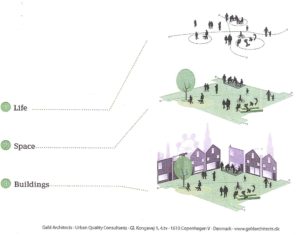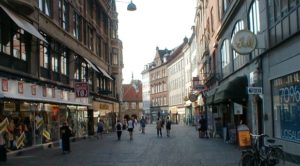Gehl Architects urban designer Kate DeSantis visited Tufts UP3 this week to share the outlook and work of Jan Gehl, a Danish architect who started his eponymous firm in 2000. DeSantis, whose undergraduate degree was in neuroscience, represents a lot of what Gehl has worked towards. He was a contemporary of Jane Jacobs, and like Jacobs, he stood in opposition to the high modernism of the time. Instead of taking the 10,000 foot view of urban design, he focused on life and people first, then space, and finally buildings. He calls into question the assumptions about people made by computer models, and insists that people actually respond more to their city’ structures. Last year, the city of Somerville worked with Gehl Studio, developing research for their comprehensive plan, Somervision and Somerville By Design.
 Copenhagen, Denmark’s capital, has gone through a dramatic shift since the 1960s, when many of its most impressive squares functioned as parking lots. They began experimenting with pedestrianized streets in 1962 with the Strøget, now the world’s longest. Since then, the city has been expanding the network of pedestrian streets and is currently working on building greater connections to the waterfront.
Copenhagen, Denmark’s capital, has gone through a dramatic shift since the 1960s, when many of its most impressive squares functioned as parking lots. They began experimenting with pedestrianized streets in 1962 with the Strøget, now the world’s longest. Since then, the city has been expanding the network of pedestrian streets and is currently working on building greater connections to the waterfront.
One thing DeSantis was sure to emphasize is that the success of Gehl Architects in Denmark isn’t necessarily going to translate to American cities. The average trip in Copenhagen is under 6 miles, far shorter than those in sprawling American cities. DeSantis and Gehl Architects have worked in San Francisco and New York City to experiment with pedestrianizing streets. Market Street, a main thoroughfare of San Francisco, was closed to cars in 2015 for the Market Street Prototyping Festival. The goal was to get strangers to interact and spend time on the street, as well as getting feedback from residents on the streets design features. For the three days of the festival, lingering activities increased by 700%, 30% more people walked along the street, especially elderly residents and children, and 15,000 people gave their design feedback through Neighborland.
A similar series of events were conducted in New York City, which saw many successful outcomes but also some negative responses. The City’s Police Commissioner was quoted as wanting to dig the project up and go back to the way it was. Though it may have made police work more difficult, it did lead to increased pedestrian traffic, reduced pedestrian injuries, and an improved perception of Times Square. Citywide, over 61 new plazas were created.

